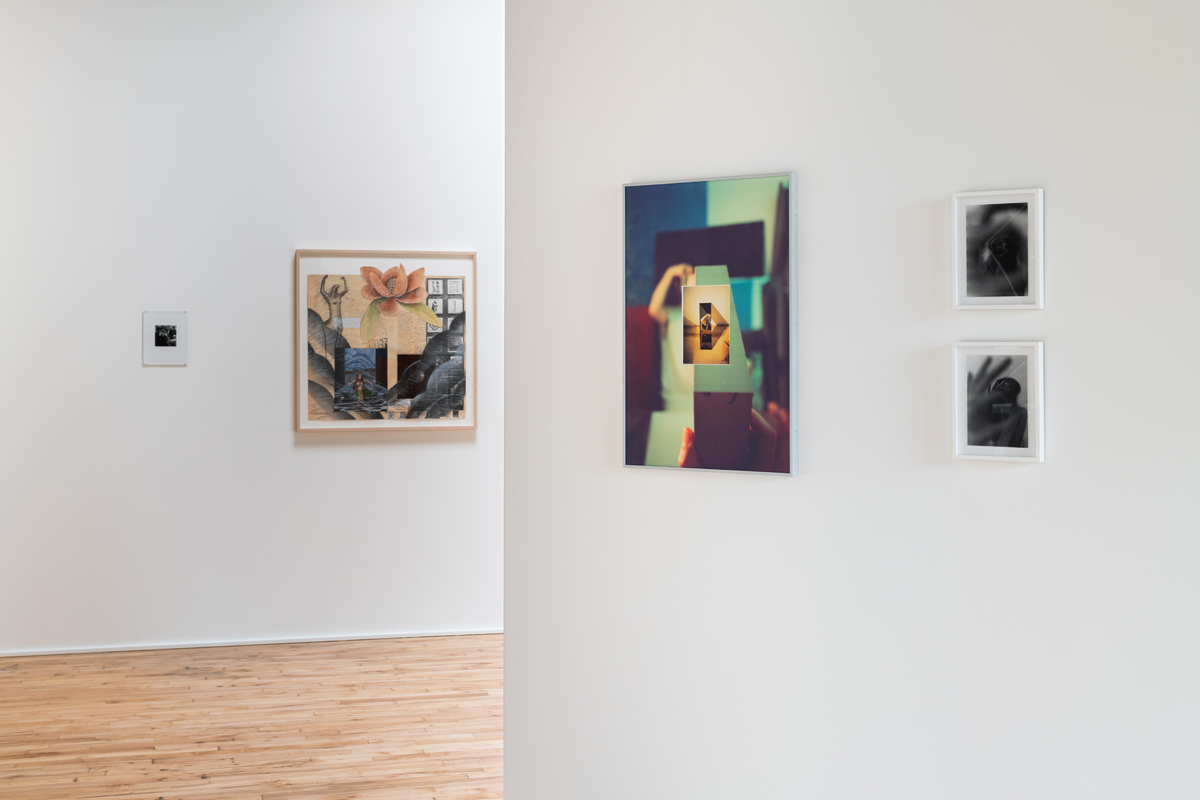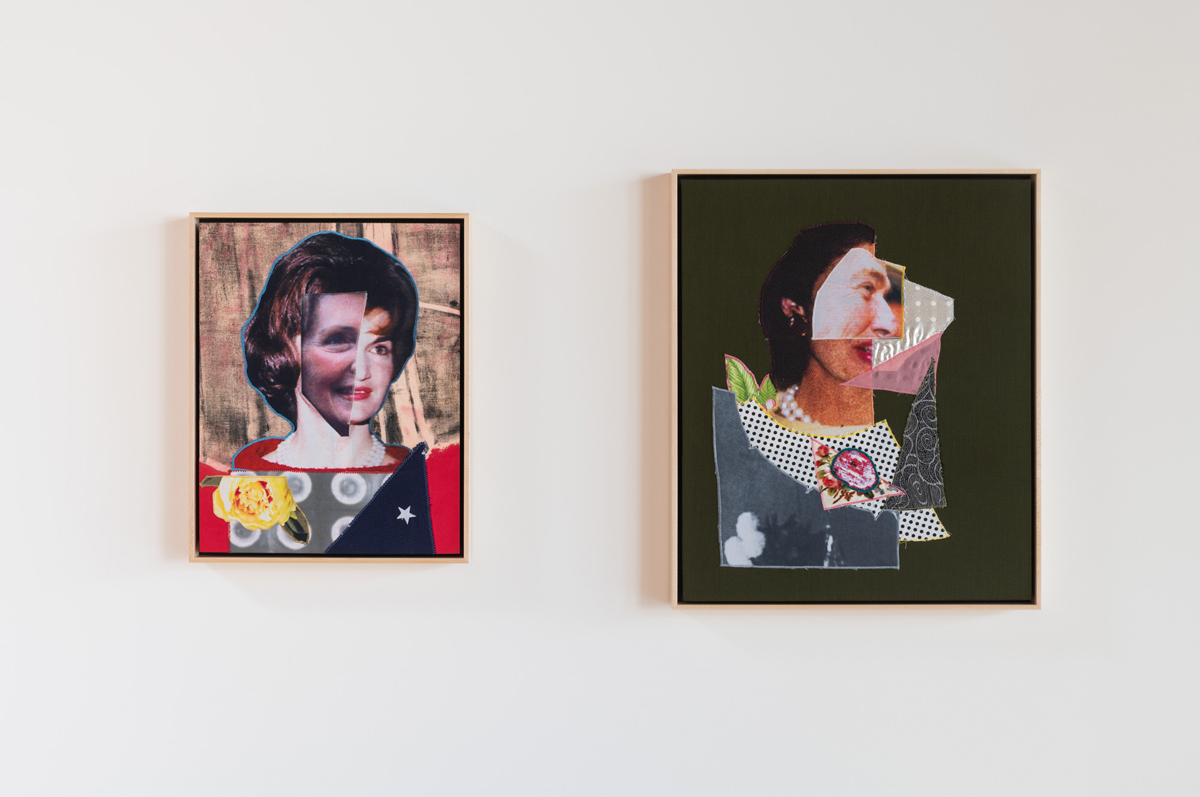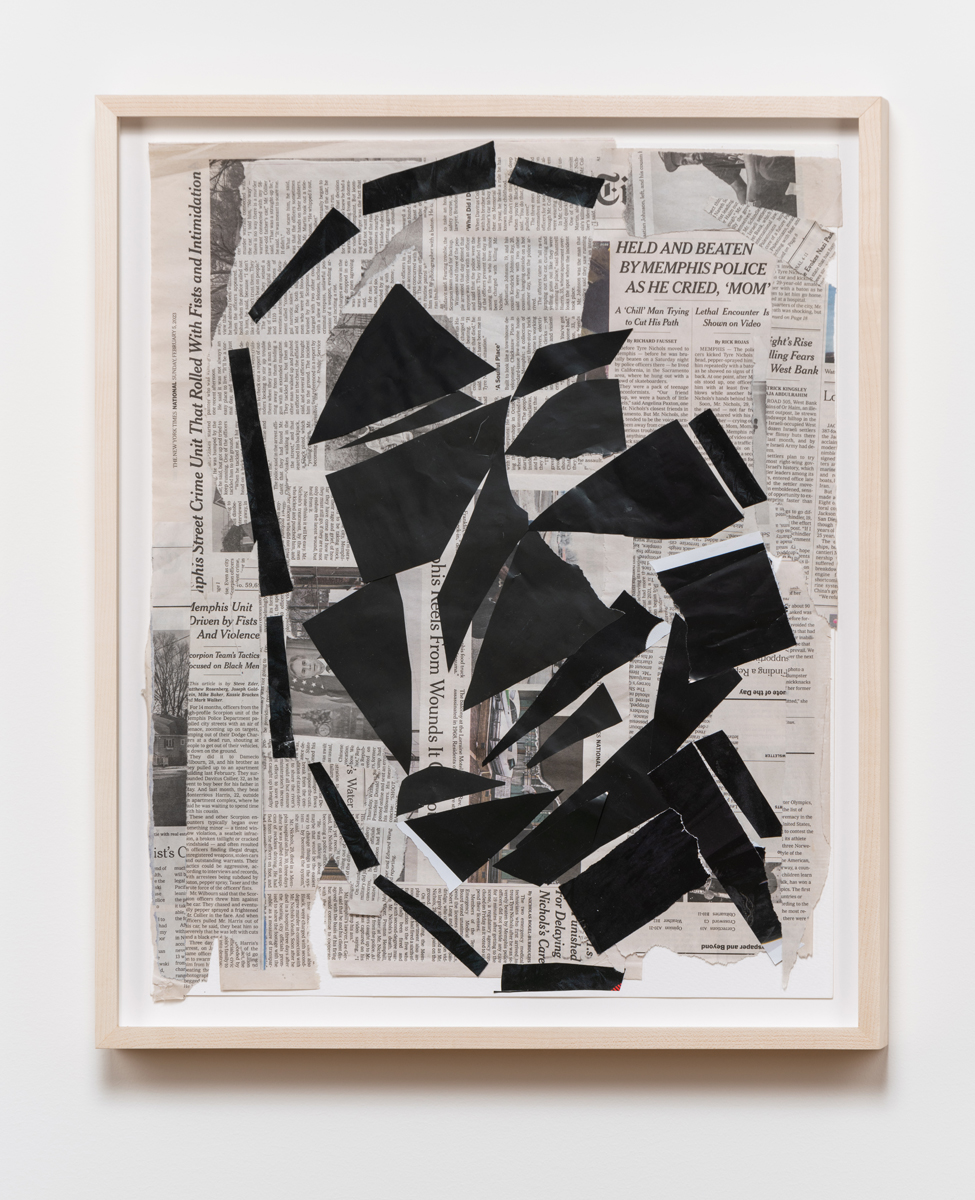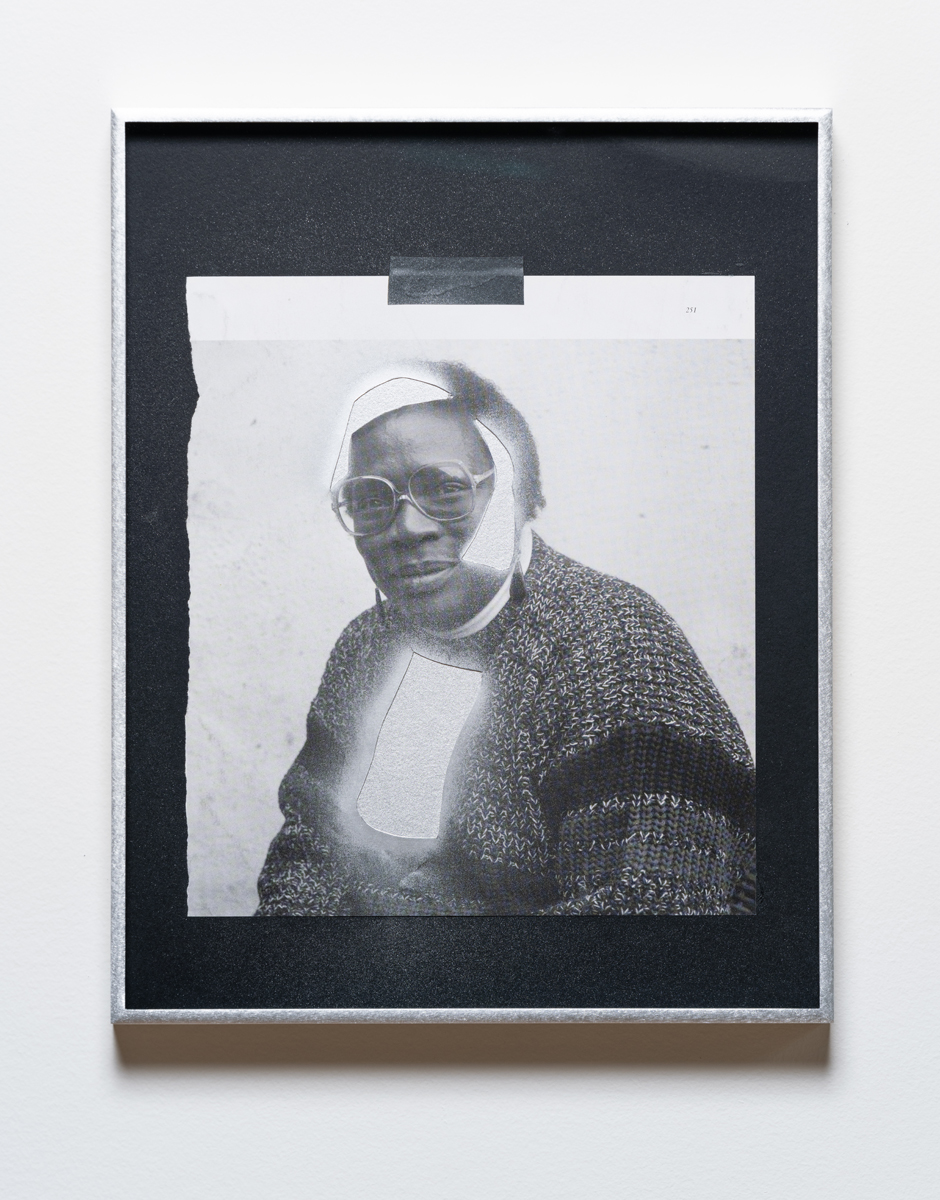 Sasha Archibald
Sasha Archibald
Collagecore: layers of possibility in the works of forty-four artists organized by Justine Kurland.

The Rose, installation view. Courtesy the lumber room. Photo: Mario Gallucci. Pictured, right foreground: Jessica Jackson Hutchins, Sweater Arms, 2010. Glazed ceramic, sweater, chair.
The Rose, curated by Justine Kurland, lumber room, 419 NW 9th Ave, Portland, Oregon, through October 28, 2023
• • •
Sometime in 2019, photographer Justine Kurland took a closer look at the piles of photo books she had at home. She separated out the volumes by iconic, eminent men—Gregory Crewdson, Martin Parr, Helmut Newton, Alec Soth, nearly 150 others—and then began meticulously cutting them up, using the fragments to make new work. What started as an experiment became a mainstay, and Kurland produced a celebrated body of collage she called SCUMB, or Society for Cutting Up Men’s Books, in reference to Valerie Solanas’s bracing manifesto.

The Rose, installation view. Courtesy the lumber room. Photo: Mario Gallucci. Pictured: Joiri Minaya, #dominicanwomengooglesearch, 2016. UV print on Sintra and fabric collage.
Collage surprised Kurland. The impetus was all punk destruction, but the handicraft delicate and fussy. The sharpness of the scissors mattered; so did the viscosity of the glue. Making a collage felt unexpectedly reparative, and its meaning slippery and alive. The pleated ricochet between the work and its source material couldn’t be entirely smoothed out. And, finally, there was the history of the medium. How was Kurland’s newfound practice ensconced in a lineage of other women who took apart so as to reassemble—by cutting and pasting, but also by gleaning and stitching and scrapping? Who were Kurland’s lodestars, and who were her fellow travelers?

The Rose, installation view. Courtesy the lumber room. Photo: Mario Gallucci. Pictured: Keisha Scarville, Passports, 2013–23. Mixed media, 3 × 4 inches each.
The Rose, a group show of forty-four artists, was born of Kurland’s research. The venue is the lumber room, an occasional gallery in downtown Portland, Oregon, owned by collector Sarah Miller Meigs. Lumber room exhibitions happen on no set schedule; I’ve lived in Portland six years, and this was the first time I’d been. Meigs’s grandfather was an Oregon timber baron—his company, Stimson Lumber, so ubiquitous that it harvested the wood for the gallery’s ceiling beams. Much of the art in the exhibition is drawn from Meigs’s private collection.

The Rose, installation view. Courtesy the lumber room. Photo: Mario Gallucci. Pictured, left to right: Francesca Woodman, Untitled, Antella, Italy, 1977–78; Mary Beth Edelson, Flowering: Spiritual Transformation, 1972; B. Ingrid Olson, Continuum, 2016; Janice Guy, Untitled, 1979.
The Rose immediately establishes an intimate, convivial atmosphere. From the street entrance, I wound my way through hanging mobiles of patterned arms and legs by Joiri Minaya, and then up a staircase flanked by K8 Hardy’s slummy collages (stained panties, big hair, Artforum defaced). The gallery proper is bisected by two diagonal walls. Some pictures are hung salon style, others carefully set askew—half over a window, for instance. There is a tiny sculpture by Shala Miller on the ground, and an assemblage by Natalie Ball leans against a corner at the angle of a kitchen broom. The sight lines are quirky and crooked, and certain pieces seem to hide in plain sight. Works in the same series or by the same artist are not necessarily cordoned. I was embarrassingly slow to recognize images with which I was already familiar, as if the exhibition had spun me around in a blindfold.

The Rose, installation view. Courtesy the lumber room. Photo: Mario Gallucci. Pictured, left to right: Bean Gilsdorf, The Witch, 2021; Bean Gilsdorf, Lone Star, 2022.
Like Mrs. Dalloway, Kurland has attended carefully, tenderly, to the invitation list, and to where each guest should sit. Her efforts are a grand success. The room hums with repartee, though there are also nudges and affronts, self-absorbed prattle, lusty adoration. Elusive self-portraits by Janice Guy, Francesca Woodman, and B. Ingrid Olson chitchat in a friendly way, while Vija Celmins’s Untitled (Web #5) and Aspen May’s California Dreaming (7) look as if they’re accidentally wearing the same dress. Jessica Jackson Hutchins’s hunk of brown ceramic in a broken chair appears transfixed by Miller’s Lilliputian figurine of a woman in control-top pantyhose, holding court with a bird balanced on the palm of her hand. Bean Gilsdorf’s textile-photo collages of America’s First Ladies—a knotty distillation of power and powerlessness if there ever was one—are rebuffed by the almost kinetic Autopsy for Tyre Nichols by Pamela Sneed, its black shards whirling against pitiless newspaper headlines, and Deborah Roberts’s collage portrait of a young Black girl, her right eye warier than her left. Keisha Scarville’s Passports series, in which the artist endlessly modifies her father’s passport photo, stirs the awkward air between Hannah Wilke’s “little cunts” and Lorna Simpson’s Black women geodes. And so on. There’s a dinner party analogy even in the installation’s slights: the choice to perch Hutchins’s raffish fused-glass sculpture in a high window does not “decenter whiteness,” as the curator hoped, but instead siphons attention.

The Rose, installation view. Courtesy the lumber room. Photo: Mario Gallucci. Pictured: Pamela Sneed, Autopsy for Tyre Nichols, 2023. Collage/magazine paper, 20 × 16 inches.
There are many figures, and many references to the figure: bodies flat and folded and spliced, large and naked, cordial and cagey. I expected flowerlike genitals, less so prosthetics, electrical sparks, blow-dryer brush turned dildo, sheet vinyl as limp as limp can be. 1970s feminist art is the blurry view from a boat headed elsewhere—or perhaps it’s a spacecraft, as per AK Jenkins’s collages: photographs torn from Robert Giard’s Particular Voices: Portraits of Gay and Lesbian Writers and highlighted with what looks like silver spray paint. The sheen confers both saintliness and extraterrestrial armor; Jenkins’s literary heroes have been anointed prophetic cyborgs.

The Rose, installation view. Courtesy the lumber room. Photo: Mario Gallucci. Pictured: AK Jenkins, Regarding Pat Parker (After Robert Giard), 2020. Mixed media collage, 14 × 11 inches.
Many bodies are playing cat and mouse with the viewer, disappearing in crops and manipulations. The subject of Gina Osterloh’s photograph Press and Erase #2 is caught climbing through a black porthole in a blood-red room. To where? Somewhere private and safe, I think, more chrysalis than escape hatch. I’ve always been flustered by Lee Bontecou’s canvas-and-steel vagina dentatas, but in this context, Bontecou’s form appears delicate and beguiling, like the entrance to a secret cave.

The Rose, installation view. Courtesy the lumber room. Photo: Mario Gallucci. Pictured, far left: Lee Bontecou, Untitled Relief, 1960. Welded steel, canvas, and copper wire.
The title of the exhibition refers to Jay DeFeo’s monumental 1966 sculpture-painting, the making of which, according to Kurland, taught DeFeo how to work in layers, building patiently through time and accretion. (DeFeo’s 2,300-pound behemoth is absent the show, though the artist is represented by a deceptively simple assemblage of folded paper and tape from 1975.) It should be said that The Rose is not, strictly speaking, a collage, and neither are many of the pieces in Kurland’s curatorial homage. To the extent that Kurland holds herself to any definition, she leans on the verb rather than the noun form—on collage as an iterative, additive process, in which unmaking necessarily precedes making. To a collagist, all the totems, bugbears, flotsam, and clichés that crowd the visual world are there to be scrambled. Nothing is fixed; an image can always be made otherwise. This is the loping, optimistic thread on which the checklist is strung: an alertness to the possibilities of undoing. As DeFeo said of The Rose, “Perfection I have not achieved, but the inevitable form of the idea, yes. Finally.”
Sasha Archibald’s essays have appeared in the White Review, the New Yorker, the Point, the Believer, and in books published by the Academy Museum of Motion Pictures, Walker Art Center, Whitechapel Gallery, and other institutions. She is a contributing editor at Places Journal and the Public Domain Review, and an editor-at-large at Cabinet.